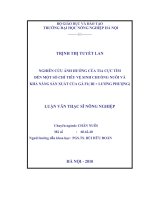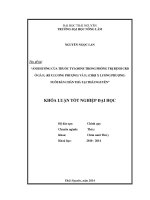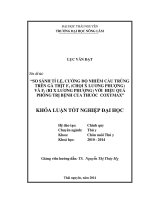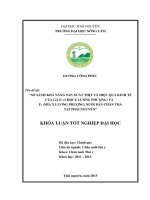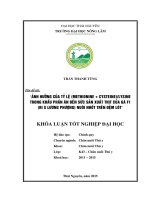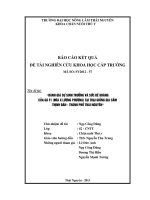Meat prodction performances of f1 choi x luong phuong chickens in rations containing different levels of metabolizable energy and crude protein with perionyx excavatus extract
Bạn đang xem bản rút gọn của tài liệu. Xem và tải ngay bản đầy đủ của tài liệu tại đây (2.89 MB, 114 trang )
i
MEAT PRODUCTION PERFORMANCES OF F1 CHOI X LUONG PHUONG
CHICKENS IN RATIONS CONTAINING DIFFERENT LEVELS OF
METABOLIZABLE ENERGY AND CRUDE PROTEIN WITH
Perionyx excavatus EXTRACT
A Thesis
Presented to the Faculty of the
College of Agriculture
Laguna State Polytechnic University
Siniloan, Laguna
In Partial Fulfillment
of the Requirements for the Degree
Master of Science in Agriculture
Major in Animal Science
HA ANH THU
June 2019
i
ii
VISION, MISSION, QUALITY POLICY, GOALS AND OBJECTIVES
Vision
The Laguna State Polytechnic University is a Center for sustainable development
initiatives, transforming lives and communities.
Mission
LSPU provides quality education through responsive instruction, distinctive
research, sustainable extension and production services for improved quality of life
towards nation-building.
Quality Policy
We, at LSPU are committed with continual improvement to provide quality,
efficient services to the university stakeholder’s highest level of satisfaction through
a
dynamic
and
excellent
management
system
imbued
with
utmost integrity,
professionalism and innovation.
Goals
1. Graduate Education is at the apex of the education system. In the field of
education, professional who aim to continued improvement of teaching
and
learning
in
the
classrooms,
delivery
of
student
services and
management of educational programs.
2.
Graduate education also one of the most effective means of developing
capabilities related to ding research that will improve educational theory
and practice in many aspects of educational process.
ii
iii
3.
Establish a graduate school that is expected to be a molder of the
Filipino minds and laboratory for the study of social, technological, economic
problems besetting our people and the country today.
Objectives
1. To
acquire
advanced
professional
training
and
technological
skills
necessary for one in maximizing his/her teaching competencies and managerial
ability in his/her field of specialization.
2. To produce quality graduates needed in the field of work.
3. To develop and elevate one’s aesthetic and personal ideals particularly in her fields
of specialization.
4. To gain advanced knowledge and skills in conducting various kinds of
research in one’s field of study
iii
Republic of the Philippines
Laguna State Polytechnic University
Province of Laguna
COLLEGE OF AGRICULTURE
APPROVAL SHEET
This research entitled “MEAT PRODUCTION PERFORMANCES OF F1
CHOI X LUONG PHUONG CHICKENS IN RATIONS CONTAINING
DIFFERENT LEVELS OF METABOLIZABLE ENERGY AND CRUDE PROTEIN
WITH Perionyx exavatus EXTRACT” prepared and submitted by HA ANH THU
in partial fulfillment of the requirements for the degree of Master of Science in
Agriculture Major in Animal Science has been examined and is hereby recommended for
approval.
ROBERT C. AGATEP, Ph.D.
Adviser
PANEL OF EXAMINERS
Approved by the COMMITTEE ON ORAL EXAMINATION with a grade of
NESTOR N. DE VERA, Ph.D.
Chairman
LOLITA L. BEATO, Ph.D.
Member
ROBERT C. AGATEP, Ph.D.
Member
LOLITA D. VIYAR, Ph.D.
Member
FLORENCIO G. REBERTA, JR., MRD
Member
Accepted in partial fulfillment of the requirements for the degree of Master of
Science in Agriculture, Major in Animal Science.
.
LOLITA L. BEATO, Ph.D.
Dean
Research Contribution No.:_
ISABELITA DOMINGO, RPChE
Chairperson, Research
MA. GRACIELA C. PRADILLADA, R.G.C.
Registrar III
iv
v
DISCLAIMER
The Laguna State Polytechnic University - Siniloan Campus nor the
researcher does not constitute to the promotion of the brands mentioned and/or
the demotion of the other brands not mentioned herein.
v
vi
DEDICATION
To Almighty God,
To my parents, Ha Van Doanh and Dinh Thi Hanh
And to all mankind especially farmers
HA ANH THU
vi
vii
ACKNOWLEDGMENT
The author would like to express her sincerest gratitude to those who
execute immeasurable help in the accomplishment of this research paper.
Dr. Nestor M. de Vera, President of Laguna State Polytechnic University who
gave the opportunity to the author at Laguna State Polytechnic University (Siniloan host
campus),
Dr. Lolita L. Beato, Dean of the Graduate Studies and Applied Research, and to the
group of panelist who gave the author permission to conduct this research,
Dr. Robert C. Agatep, for his kindness, guidance, advice, support and ideas which
enable the author to finish this research,
Dr. Lolita D. Viyar, for giving her time, meticulosity and effort in checking this
manuscript,
Her father Ha Van Doanh and mother Dinh Thi Hanh who gave their full support
and for the ecouranging inspiration during the conduct of the study,
Nguyen Thi Lan, Pham Van Dien, Bui Ngoc Son and Le Cong Van, her friends
who gave their opinion, concern, and care for the that lead to the
successful completion of this study.
vii
viii
ABSTRACT
A 2x3 complete factorial experiment in a Randomized Complete Block Design was
conducted in order to determine the meat production performances of F1 Choi x Luong
Phuong chickens in rations containing different levels of metabolizable energy and crude
protein with Perionyx excavatus extract.
Results show that the feed consumption, feed conversion efficiency, protein
efficiency ratio and the gross profit margin in raising F1 Choi x Luong Phuong chickens
up to 90 days of age were significantly affected by the interaction of the inclusion of 1.8%
(by weight) P.excavatus extract and the levels of metabolizable energy and crude protein
in the ration. The higher levels of metabolizable energy and crude protein in ration
containing 1.8% P.excavatus extract significantly increased the feed consumption of the
chickens. On the other hand, lowering the levels of metabolizable energy and crude protein
in the ration containing 1.8% P.excavatus extract significantly improved the feed
conversion efficiency, protein efficiency ratio and the gross profit margin. Besides,
significant main effects of the inclusion of 1.8% P.excavatus extract and of the different
levels of dietary metabolizable energy and crude protein were observed on the final body
weight, weight gain, average daily gain and energy efficiency ratio. These varibles were
significantly improved by the inclusion of 1.8% P.excavatus extract in the feeds
irrespective of levels of metabolizable energy and crude protein in the ration. On the
other hand, significantly higher final body weight, gain in weight and average daily gain
were posted by the experimental chickens fed with ration containing
higher levels of metabolizable energy and crude protein, irrespective of the
viii
ix
inclusion or absence of 1.8% P.excavatus extract in the feeds. Significantly higher energy
efficiency ratio was observed among the chickens fed with experimental rations having
lower levels of metabolizable energy and crude protein regardless of the inclusion or
non-inclusion of 1.8% P.excavatus extract in the feeds. On the other hand, the dressing
percentage, cut-up parts yield and carcass color, tenderness and water holding capacity
were apparently unaffected by the inclusion of 1.8% P.excavatus extract in the feeds and
the levels of metabolizable energy and crude protein in the rations. However, slight
differences between sexes were observed on the dressing percentage, breast and fat yield.
The males have slightly higher dressing percentage and breast yield but not fat yield
compared with the female F1 Choi x Luong Phuong chickens.
The author therefore recommends that rations with 1.8% P.excavatus extract
and containing 2772 Kcal ME/kg with 21% crude protein at 1 to 45 days of age and 2790
Kcal ME/kg with 18% crude protein at 46 to 90 days of age can be fed to improve the
meat production performances and profitability in raising F1
Choi x Luong Phuong chickens. In addition, utilization studies on the use of other localavailable feedstuffs in formulating feeds for F1 Choi x Luong Phuong chickens can
be done to possibly lower feed cost and improve production performance. Moreover, the
evaluation of the metabolizable energy and crude protein levels required by other native
chicken breeds can be done in order to come up with the optimum levels of these
nutrients for improved performances
and more profitable production.
ix
x
TABLE OF CONTENTS
Page
TITLE
i VISION,
MISSION, QUALITY POLICY, GOALS AND OBJECTIVES
SHEET
ii APPROVAL
iv DISCLAIMER
v DEDICATION
vi
ACKNOWLEDGMENT
vii
ABSTRACT
viii
TABLE OF CONTENTS
x LIST
OF TABLES
xiii LIST OF
APPENDIX PLATES
xiv
Chapter
1
2
THE PROBLEM AND ITS BACKGROUND
1
Introduction
1
Background of the Study
4
Theoretical Framework of the Study
5
Conceptual Framework of the Study
6
Statement of the Study
8
Hypothesis of the Study
8
Significance of the Study
9
Scope and Limitations of the Study
9
Definition of Terms
10
REVIEW OF RELATED LITERATURE AND STUDIES
Metabolizable Energy and Crude Protein
x
12
12
xi
Performance of Chickens
3
4
16
METHODOLOGY
26
Experimental Design
26
Materials
27
Sampling Techniques
29
Subject of the Study
29
Special Technicques and Procedure
29
Preparation and disinfection of the experimental
poultry house and equipment
29
Brooding management
30
Feeding management
31
Water management
31
Preparation and formulation of experiment ration
31
Data Gathering Procedure
33
Data Processing and Statistical Analysis
36
PRESENTATION ANALYSIS AND INTERPRETATION
OF DATA
37
Body weight
37
Gain in Weight
39
Average Daily Gain
40
Feed Consumption
42
Feed Conversion Ratio
43
Energy Efficiency Ratio
45
Protein Eficiency Ratio
47
Gross Profit Margin
48
Dressing Percentage and Carcass Yield
50
xi
xii
5
Carcass Characteristics
50
Carcass color
51
Tenderness
52
Water Holding Capacity
53
SUMMARY OF FINDINGS, CONCLUSIONS AND
RECOMMENDATIONS
55
Summary of Findings
56
Conclusions
60
Recommendations
62
BIBLIOGRAPHY
63
APENDIX TABLE
69
APENDIX PLATE
72
xii
xiii
LIST OF TABLES
Table
Page
1
Feed Formula with 1.8% (by weight) Perionyx excavatus extract
32
2
Feed Formula without Perionyx excavatus extract
33
3
Average final body weight of the chickens, in grams
38
4
Average gain in weight of the chickens, in grams
39
5
Average daily gain of the chickens, in grams
41
6
Average feed consumption of the chickens, in grams
43
7
Average feed conversion ratio of the chickens
45
8
Average energy efficiency ratio (EER) of the chicken
46
9
Average protein efficiency ratio (PER) of the chickens
48
10
Average gross profit margin (GPM) of the experiment
49
11
Dressing percentage and Cut-up parts yield
50
12
Carcass color of experimental chicken meat
52
13
Tenderness of experimental chicken meat
53
14
Water holding capacity of experimental chicken meat
54
xiii
xiv
LIST OF APPENDIX PLATES
Appendix plate
Page
1
Experimental cages with feeder and water
71
2
Commercial Bran Lac Hong F20 and F24
71
3
Ingredients used in the preparation ration of feed
71
4
Perionyx excavatus extract
72
5
Day old experimental chicks
72
6
Brooding period
72
7
Experimental chicken, 12 weeks of age
73
8
Weighing live chicken
73
9
Weighing slaughted chicken
73
10
Dressed chicken
74
11
Removal at bones from chicken thigh
74
12
Weighing of carcass
74
13
Samples sent to laboratory for determination
of cacass
characteristics in terms of tenderness, water holding
capacity and color
75
xiv
11
Chapter 1
THE PROBLEM AND ITS BACKGROUND
Introduction
Poultry farming has been a traditional industry of the Vietnamese and plays
an important role in their lives because chicken meat is always the most important and
popular in Vietnamese meal. Over the years, the population of Vietnam developed rapidly
and lead to the demand for food to increase. Therefore, the livestock and poultry
industries in the country has develop strongly. Vietnamese consumers trend always
prefer to use meat products that are native, natural, clean and high quality, the meat must
be very tasty and solid. Since then, scientists have been required to research and produce
high-yielding and high-quality poultry varieties to meet the different tastes of consumers.
Pure native chicken is the most favorite in Vietnam but some native breds have to be fed
for 6 months and above before they can be slaughtered such as the Ri, Mia, Choi, Ho, Ac,
Tre and Dong Cao, among others. To satisfy the demands of the market, chicken farms
created hybrid chickens which are crossbreed between native and imported chickens, or
can be crossbreed between native chicken breeds for the purposes of getting both
outstanding characteristics, namely deliciousness of meat and at the same time
shortening the feeding period. One of the new breeds of chickens that has been
bred to meet the needs of consumers is the F1 Choi x Luong Phuong chickens. This
F1 breed has both the fast growth of Luong Phuong chicken and the deliciousness,
strong health of Choi chicken. In order to earn the advantages of the Choi chicken
and Luong
2
Phuong chicken and remove their disadvantages at the same time, Mr. Pham Dinh Dua
from the Hai Duong poultry hatchery in Vietnam had successfully developed the F1
chicken by crossing the Choi male and the Luong Phuong female in 2008.
The F1 Choi x Luong Phuong chickens are very well adapted to conditions and
climate of Vietnam. They have a lot of prominent features with smooth feathers,
mostly is black feathers. High and yellow foot, large body, meat is light yellow, firm
and solid, tasty bold. Besides, an easy raising way and rapidly growth, reaching 1.8
kg (hens) and 2.6kg (roosters) after about 115 days of age, they have higher price than
other broiler chickens being raised in Vietnam
This new hybrid chicken has been started to be raised in some farms and bring
economic profits for chicken raiser, although it is not that popular in whole Vietnam.
However, there are a lot of problems in the feeding process that exist, especially on some
important issues in their ration and nutrition. At present, the rations mostly are the freeranging diets, which are mixed by the chicken raisers with the addition of by-products
from the industrial processesing of alcohol, beer, beans, etc., to supplement with
commercial bran. This feeding scheme leads to feed wastage because the farmers can
not balance the amount of the energy and protein for optimal chicken growth and meat
production performances. Meanwhile, if the feeding will only use the commercial bran,
the cost of feed will take up considerable part of the profit because commercial bran is
not only expensive, but also can supply more energy and protein than the actural
nutritional requirement of the chicken.
3
The energy requirement of poultry is presented by the value of metabolizable
energy. According to to Tu Quang Hien (2003), energy and protein have a certain
correlation. When the level of metabolizable energy is low, the body will resolve
down protein to provide energy, so the feed conversion ratio will increase. When the
metabolizable energy is excess, the body will enhance fat accumulation. The poultry
meat production just can be increased when the ratio of metabolizable energy (ME) and
crude protein (CP) lies in their ability to regulate. Therefore, the ME/CP ratio (Kcal/
%CP) in rations is too high or too low are both affect the weight gain, the effective of
using feed and the meat quality of the poultry. The basic levels of metabolizable energy
is 2,800 Kcal/kg of feed and a basic level of protein are 23%, 22% and 18%
(according to each stage). Increasing energy in the diet will increase fat intake.
Increasing protein will increase the ratio of water and protein in meat but reduces the
amount of fat and energy in meat.
Reducing the cost of feeding through decreasing the rate of commercial bran and
replacing it with other cheaper feeds such as Perionyx excavatus, corn bran, rice bran and
soybeans, without changing the ME:CP ratio to get the best FCR is a promissing way of
improving the profitability in chicken raising. At the same time, establishing a basis for
recommending the use of Perionyx excavatus in the rations that provides fully the
energy and protein requirements for the F1
Choi x Luong Phuong chicken breed has to be done. Hence, this study.
4
Background of the Study
Although Nguyen Cong Hau (2013) studied and compared between pure Choi
chickens with F1 Choi x Luong Phuong, but his formulation of feed was only industrial
bran with 2800 Kcal/kg and 21% protein. And he had to feed their experimental chicken
up to 14 weeks of age to achieve 1850 grams’ body weight.
In order to reduce the time of raising chicken and reach the higher body weight, it
is important to have a study and research another ration for F1 Choi x Luong Phuong
chickens with different levels of metabolizable energy and crude protein to determine
which level of metabolizable energy and crude protein is suitable with F1 Choi x Luong
Phuong chickens in term of meat production performances.
At the same time, in poultry production, feed often costs for about 70% of the
total cost of poultry production, while the price of high protein feed is much higher than
the high energy feed. In recent years, the price of commercial bran increased due to the
fact that Vietnam has to import a lot of feed ingredients, especially the ingredients to
produce high protein feed. This has greatly affected the cost of animal husbandry.
Therefore, the selection of ingredient sources has high protein, easy to find and cheap is
very significant, contributing to the improvement of husbandry productivity, reduce
production costs, bringing high economic efficiency. According to Cao Thi Yen Chi
(2008), one of the sources of high protein feed is worth paying attention to many of the
preeminent features of the Perionyx excavatus. This is considered to be an excellent
source of protein for chicken because they contain all the nutrients necessary for the
growth and
5
development of them (crude protein about 66.14% 7.4%, total minerals about
13.23%). Moreover, Perionyx excavatus is the favorite foods of poultry. In addition, the
Perionyx excavatus culture process is very simple, most of the farmers are able to apply,
because the feed source for worms is mainly available by-products and wastes are very
cheap and available from cultivation and livestock.
According to Vu Dinh Ton et al (2009), Perionyx excavatus is called Redworm,
genus Pheretima, family Megascocidae. They belong to the faunal earthworm group,
often living in decaying organic matter. A Perionyx excavatus has a relatively small
size, about 10-15 cm length, the width of the adult can reach 0.1 - 0.2 cm, red or
plum color depending on age. It has high protein content so that Perionyx excavatus is
considered as a valuable source of nutrition for cattle, poultry and ogratic species. In
addition, Perionyx excavatus is also used in medicine and in technology for animal feed
processing.
However, the use of Perionyx excavatus or chicken production have been studied
just on broiler, not on F1 Choi x Luong Phuong chickens.
Theoretical Framework of the Study
According to Oldenbroek and Van der Waaij (2014), the phenotypic variance or
the productivity of the animals can be deetermined by the combined effect of the
genotypic and the environmental variances, or simply by the genetic make-up and the
environmental condition upon which the genotype has been exposed into. In this study,
to raise successfully the F1 chickens (Choi x Luong
6
Phuong) with maximum weight gain, not only does depend on the strain of
chicken but also on feed quality. It was claimed that over 70% of the total chicken
production cost was incurred on feed management activities. Thus, any activity to
improve the performance of F1 Choi x Luong Phuong chickens through the
modifiction of their diets can inevitably have a profound effect on the profitability of
chicken farming.
Conceptual Framework of the Study
The conceptual model of the study is presented in the Figure 1. As shown in the
figure, left box contains the independent variables, which include the Factor A: the
rations with and without 1.8% Perionyx excavatus extract; and the Factor B: the different
levels of metabolizable energy and crude protein, in the ration which were maintained to
be at 132 at 1 to 45 days of age, and at 155 at
46 to 90 days of age.
In the ration for 1 to 45 days of age, B1 contain 3,036 Kcal ME/kg and
23% crude protein, B2 has 2,904 Kcal ME/kg and 22% crude protein while B3 has
2,772 Kcal ME/kg and 21% crude protein. The ration intended for 46 to 90 days of age
contain 3100 Kcal ME/kg and 20% crude protein for B1 and 2,904
Kcal ME/kg and 22% crude protein as well as 2,772 Kcal ME/kg and 21% crude protein
for B2 and B3, respectively.
The right box presents the dependent variables which include the indication
of the production performances of the F1 Choi x Luong Phuong chickens in such as
body weight, feed consumption, feed conversion ratio,
7
protein efficiency ratio, energy efficiency ratio, gross profit margin, dressing percentage,
cut-up parts yield and carcass characteristics. The arrow connecting the two boxes signify
a cause and effect relationship between the independent and the dependent variables.
Independent Variables
Dependent Variables
8
Factor A: Perionyx excavatus extract
Performance of 90-day old F1 Choi x
Luong Phuong chickens.
A1: Rations with 1.8% (by weight) Perionyx
excavatus extract
1.
Body weight
2.
Feed consumption
3.
Feed conversion ratio
4.
Protein efficiency ratio
B1: 3036 Kcal ME/kg and 23% CP at 1 to 45
5.
Energy efficiency ratio
days of age
6.
Gross profit margin
7.
Dressing percentage
8.
Cut-up parts yield
9.
Carcass characteristics in
A2: Rations without Perionyx excavatus
extract
Factor B: ME and CP levels
3100 kcal ME/kg and 20% CP at 46 to
90 days of age
B2: 2904 Kcal ME/kg and 23% CP at 1 to 45
days of age
2945 kcal ME/kg and 20% CP at 46 to
terms of:
9.1. Tenderness
90 days of age
9.2. Water holding capacity
B3: 2772 Kcal ME/kg and 23% CP at 1 to 45
days of age
9.3. Color
2790 kcal ME/kg and 20% CP at 46 to
90 days of age
Figure 1. The conceptual model of the study.
Statement of the Study
This study was conducted to determine the performance of F1 Choi x Luong
Phuong crossbred chickens under different levels of metabolizable energy and crude
protein in the ration with or without Perionyx excavatus extract. Specifically, this study
sought to answer to the following questions:
1.
Is the performance of the F1 chicken significantly affected by the inclusion of
1.8% Perionyx excavatus extract in the feed?
2.
Is the performance of the chicken significantly affected by the different levels of
metabolizable energy and crude protein in the ration?
3.
Is there a significant interaction between the effects of the inclusion of Perionyx
excavatus extract and the different levels of metabolizable energy and crude protein in
the ration on the performance of the chickens?
Hypothesis of the Study
This study tested the hypotheses: 1) The different levels of metabolizable energy
and crude protein in the ration did not affect significantly the production performances of
F1 Choi x Luong Phuong chickens at 90 days of age in terms of body weight, feed
consumption, feed conversion ratio, protein efficiency ratio, energy efficiency ratio,
gross profit margin, dressing percentage, cut-up parts yield and carcass characteristics;
2) The inclusion of 1.8% Perionyx excavatus extract in the ration have no significant
effect on the performance of the chickens; and 3) The different levels of metabolizable
energy and crude protein and the
inclusion of Perionyx excavatus extract in the ration have no significant
interaction effect on the performance of the chickens.
Significance of the Study
The study figured out the meat production performances of F1 Choi x Luong
Phuong chickens fed with the inclusion of Perionyx excavatus extract in ration containing
different levels of metabolizable energy and crude protein under captive condition. This
will help the chicken raiser achieve the high gross profit margin through decrease the
feed consumption and feed conversion ratio of chicken, thus saving cost of feeds in
raising chicken.
Scope and Limitations of the Study
A 2x3 complete factorial experiment in a Randomized Complete Block Design
was followed in this study. The study was conducted from May 2018 to August 2018 at
Yen The district, Bac Giang province, Vietnam.
This study was focused on determining growth of F1 Choi x Luong
Phuong chickens in different levels of metabolizable energy and crude protein with
1.8% Perionyx excavatus extract in term of: body weight, feed consumption, feed
conversion ratio, protein efficiency ratio, energy efficiency ratio, gross profit margin,
dressing percentage, cut-up parts yield and carcass characteristics in terms of tenderness,
water holding capacity and color.
